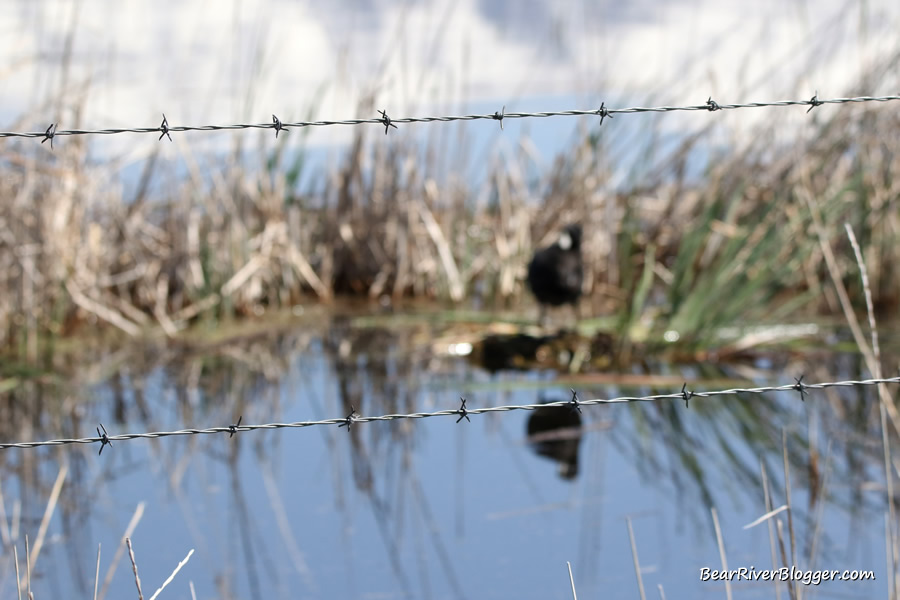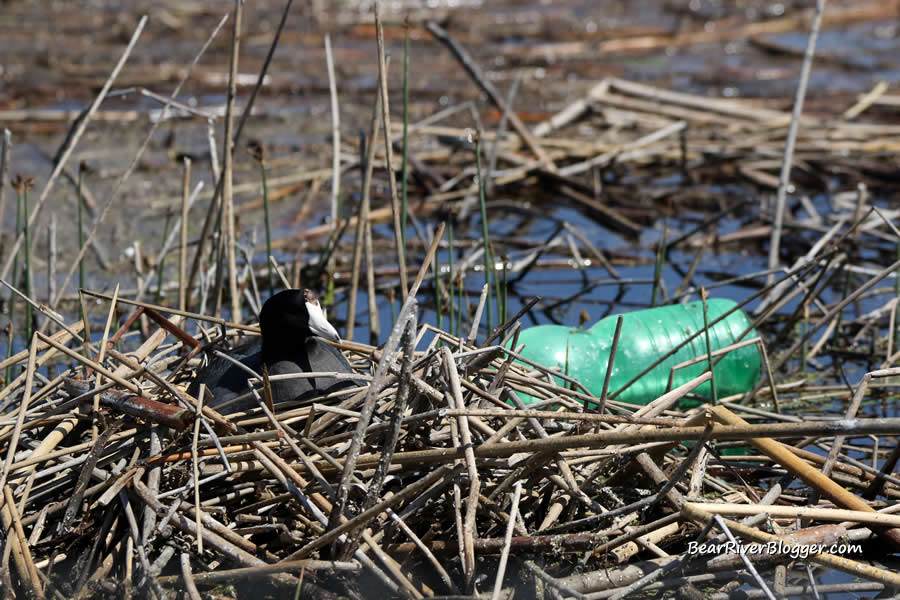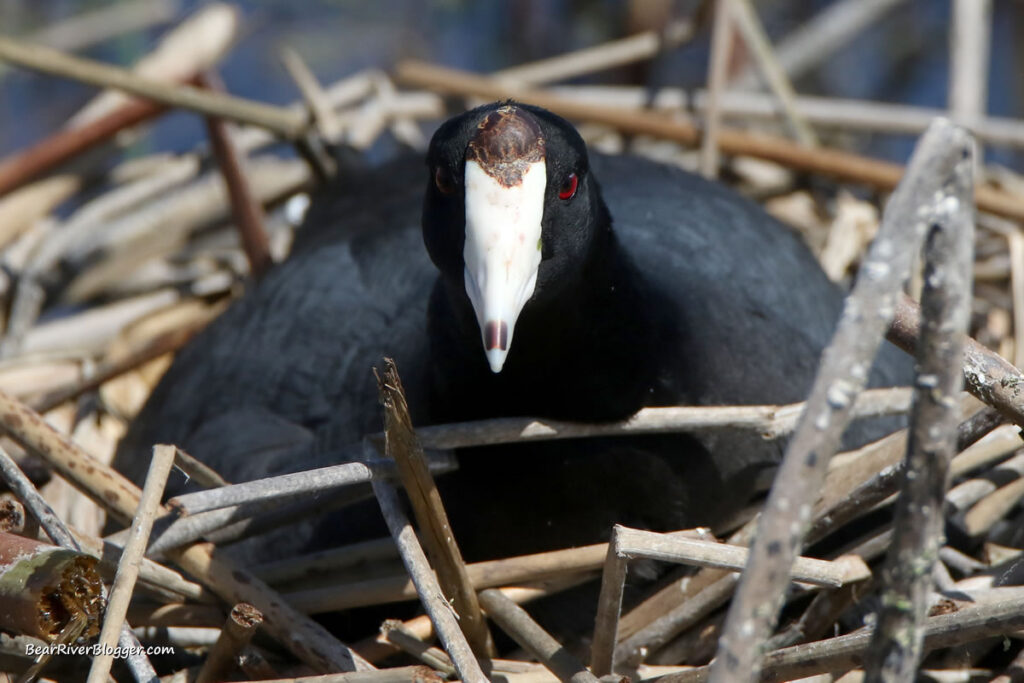As I sit at my laptop to work on this blog post my mind has been trying to meander a bit, something quite common when the topic at hand involves birdwatching, bird photography, or just about anything at all to do with wild birds.
It can be quite frustrating at times, too, I will admit.
What should only be a 2-hour blog post to pen sometimes takes me all day to write because, well, I get a little distracted, okay, maybe a tad more than “a little” distracted, when looking at bird photos.
As such, I would assume most if not all birdwatchers out there might confess this same notion as well, I’m one who certainly likes to stop what I am doing when there’s cause and reason to admire a really great bird photo.
It should be no big surprise to learn, however, that I truly love both photographing birds and gathering captivating stories for other birders to be delighted by here on this website even more, a lot more in fact.
The tightly composed image above, one depicting an American coot earnestly curled up on its nest, was photographed this past spring on the Bear River Migratory Bird Refuge and is what I would claim to be a reasonable example of a fairly captivating bird photo as I just love this particular coot’s stern, maybe even a bit perturbed, expression.
Thumbing through thousands of bird photos on my hard drive in search of a topic to write about, this particular image seems to always catch my attention as I do consider it to be a really interesting photograph of an American coot.
Okay, maybe my passion for bird images and nature photography is a bit more on the compulsive side I will admit.
Some of you who really know me might even lay claim that it borders on the, ummm, well, let’s call it the obsessive end of the birdwatching spectrum, for lack of a better term I guess.
As such, bird photography is a huge part of my daily life and, honestly, I wouldn’t want or have it any other way.
Truth be told, photographing birds on the famed Bear River Migratory Bird Refuge auto tour route was actually the driving force, the catalyst if you will, that started Bear River Blogger almost 6 years ago and continues to sustain that momentum even to this very day.
But in my defense, birdwatching and bird photography are both just plain awesome so why not “jump in the pool” with both feet wielding a “boots still on” kind of attitude, right?
I mean, seriously, birdwatching and nature photography are great hobbies for anyone at any age or experience level to get involved with and I hope this whole website conveys that in some manner.

With regards to bird photography, this past spring was one of the best spring seasons I have ever seen for photographing birds on the Bear River Migratory Bird Refuge, well, on certain parts of the refuge, anyway.
If you think back to the record-setting wet spring Utah was blessed with this year, the Bear River flooded and some of the Bear River Migratory Bird Refuge itself, as well as a lot of surrounding private lands, were inundated with flood waters for several months, creating new but temporary wetland habitats along Forest Street.
And with those newly flooded acres, countless numbers of birds literally lined the upper portion of Forest Street for months just begging for their pictures to be taken.
Well, maybe not begging but the birds were certainly in very close proximity to the asphalt road so it was very common, almost expected at times, to come home with some great bird images.
But that doesn’t mean there weren’t challenges in photographing birds during that time because, well, there most certainly were.

As is often the case with bird photography, obstacles such as barbed wire fences in the way, as one common example I was faced with, had to be dealt with in order to photograph a good, clean, natural-looking image of a wild bird depicted in a wild place.
Both of the American coot images posted above had the same obstacle to overcome, a poorly positioned barbed wire fence that sat between me and both of the birds.
In each case, however, the coot was situated where I could slightly maneuver my vehicle to where my 600mm Tamron lens was able to zoom close enough between the barbed wire strands to where they were not affecting the image at all.
This is one of the big advantages of photographing birds with such a large zoom lens.
Even though I had to really get in close with the large lens so the barbed wire wasn’t seen, I still had enough space around the coots to where I was able to crop the images the way I wanted to.
The top coot American image posted above gave me a bit more of a challenge, however, as an annoying barbed wire fence was only half of the problem I faced.
In addition to finding the right angle to photograph through the fence, I also had to position myself to where the greed soda bottle that was sitting just to the right of the nest was out of the image as well.
It took a few tries of positioning and repositioning my vehicle to get the one and only angle where both the barbed wire and the soda bottle weren’t in the image at all but, as you can see with the above-posted image, I was successful in my efforts to capture a clean, natural-looking image of the nesting American coot.
Obstacles such as barbed wire and garbage are oftentimes challenges bird photographers have to take into consideration and work around to get a natural-looking bird photograph.

As noted before, in both of these instances having a large 600mm Tamron lens made both photography situations workable as I was able to tightly zoom in around the bird, thus leaving the annoying man-made objects completely out of the photograph.
There are a lot of things to take into consideration when photographing birds in natural settings and some of these obstacles, including fences, garbage, and other man-made objects, do pose a challenge but can usually be overcome with a little patience, a large zoom lens, and trying some different angles whenever possible.
In both of these cases, the American coots were close enough that I could really zoom in on the bird but far enough away that neither coot was bothered by the repositioning of my vehicle.
Feel free to head on over to our newly created Bear River Blogger Facebook page to post your own nature and bird photographs and to ask questions about birds or bird photography.
I hope in some way this helps any of you who are starting out with bird photography as a hobby.
If you are new to our blog, we offer you to head on over to our subscribe page and sign up for email notifications for future blog posts about our birdwatching and nature photography excursions.
And, as always, we are very thankful for those of you who help keep this website growing by sharing some of your favorite blog posts on your favorite social media outlets for others to read and enjoy.
(Tundra Swans Feeding. For short nature clips like this one and interesting stories about the natural world around us, check out our Bear River Blogger channel on YouTube for videos and updates from our travels while out in nature, both on and off of the famed Bear River Migratory Bird Refuge.)




